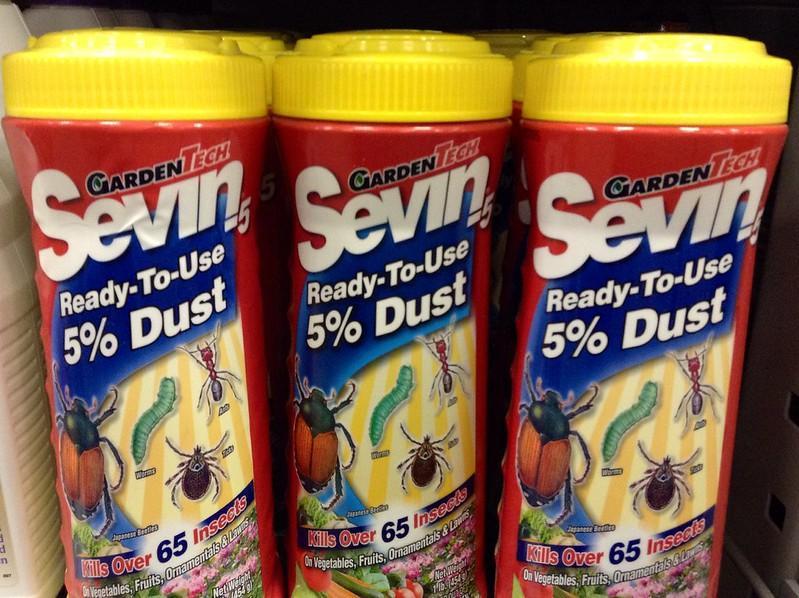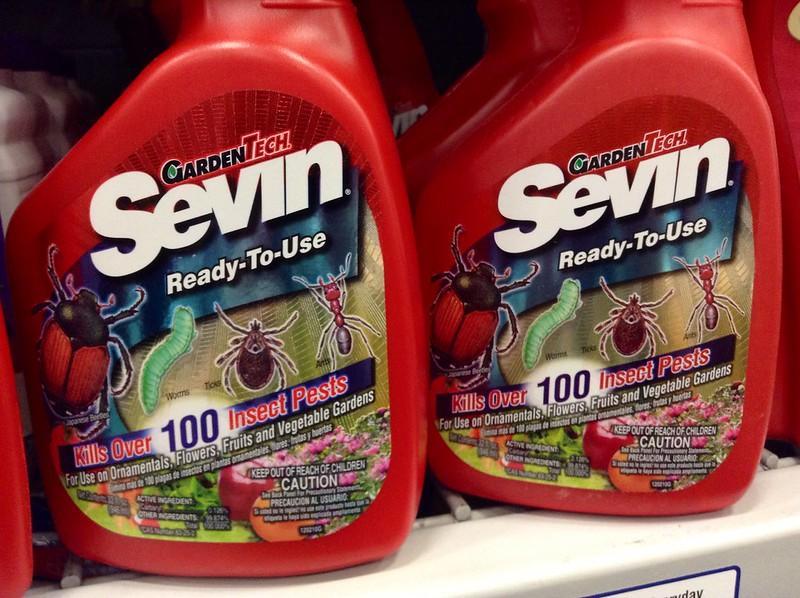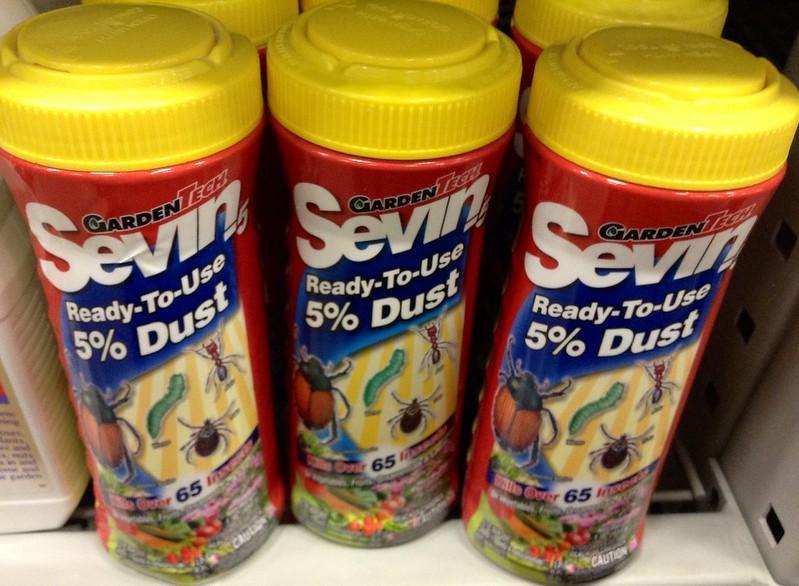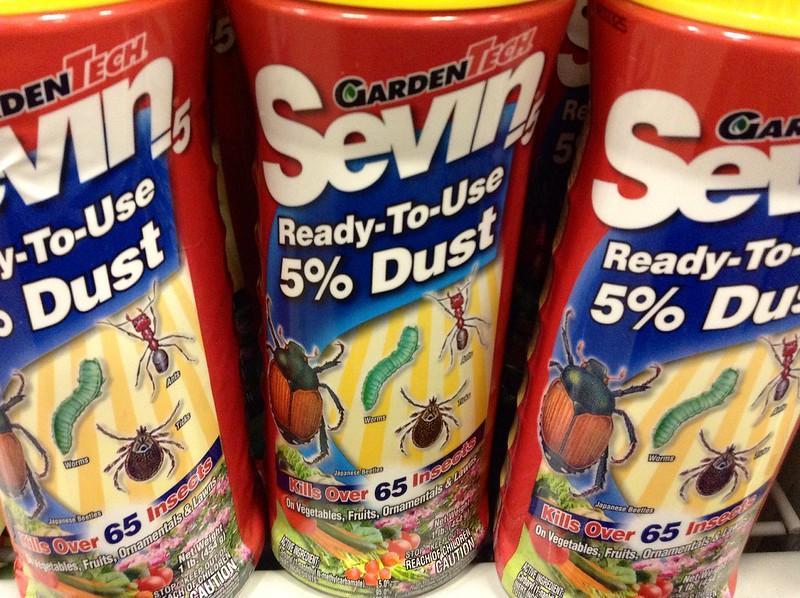Maintaining a garden is difficult, especially considering the variety of insects that can attack and damage your plants. The use of insecticides is one method for preventing this from happening; however, many types of aerosol insecticides wind up being too harsh on your plants and are unsafe to use on fruits and vegetables that are intended for human consumption. And that is where dust-type insecticides such as Sevin dust come in!

Sevin Ready-to-Use Dust is designed to destroy over 150 types of insects that infest homes and gardens.
For more than three decades, residents and professionals alike have relied on Sevin as a reliable insecticide. Sevin is utilized in a variety of landscape settings, including lawns, flower beds, and even vegetable gardens. Some people even refer to Sevin Dust as Nature’s Seasoning of the realm of insecticides when talking about it.
Sevin Dust contains carbaryl, which is toxic to many plant pests. Although carbaryl is effective against insects that find their way indoors, it should not be used inside. After application, the dust will continue to be effective for up to three months, and it can be reapplied as often as once every seven days at the earliest.
If, however, you are still doubtful about this bug killer, let’s delve a little more.
What Is Sevin Dust?
If you are a gardener, you are likely familiar with Sevin Dust. It is a powdered outdoor insecticide that is marketed by Garden Tech and is a top-selling product in this category.
Carbaryl, the active ingredient in Sevin Dust, is a neurotoxin that induces convulsions in insects upon contact. Also, it causes very little harm to birds and mammals and is widely used as a pesticide in agriculture. All in all, Sevin dust effectively safeguards food crops, vegetable gardens, and houseplants from insect infestations.
What Insects Does Sevin Dust Kills?
Sevin Dust is meant to kill approximately 150 different types of common insects; nevertheless, it can potentially eliminate practically any type of bug that it comes into contact with outdoors. It is most effective against insects that feed on crops, such as ants, squash bugs, beetles, cabbage worms, caterpillars, and boxelder bugs.
It just takes a few minutes for Sevin Dust to kill insects; even after it has dried, the dust will continue to kill insects for several weeks before reapplying.
Here is a list of bugs that Sevin dust can kill, as provided by the manufacturer on their website:
- Ants
- Armyworms
- Chiggers
- Colorado Potato Beetle
- Cucumber Beetles
- Earwigs
- Fall Armyworms
- Flea Beetles
- Fleas
- Cabbage Worms
- Japanese Beetles
- June Beetles
- Lace bugs
- Leafhoppers
- Millipedes
- Periodical Cicada
- Raspberry Aphid
- Rose Slugs
- Rose Aphids
- Sod Webworms
- Spiders
- Spittlebugs
- Squash Bugs
- Stink Bugs
- Strawberry Weevil
- Tent Caterpillars
- Ticks
- Tomato Fruit worms
- And many more…
Related: How To Get Rid Of Thrips From Your Garden For God? The Ultimate Guide
How Does Sevin Dust Works?

The chemicals in Sevin dust produce convulsions in the insects’ bodies, which then kill them.
Sprinkling Sevin Dust powder over your garden’s plants and trees or on top of any bug homes is an effective way to get rid of pest insects. Insecticides such as Sevin Dust and many others containing carbaryl cause extreme overstimulation of the insect’s nervous system, making it incapable of controlling its own breathing and movement.
However, the bugs must either ingest or come into direct contact with the pesticide for it to be effective. As a result of the chemical’s effects, the insects’ bodies go into convulsions, and they become totally helpless. The insect will eventually perish since it will be unable to survive without air, movement, or food.
Potential Side Effects Of Sevin Dust

Carbaryl is Sevin dust is extremely poisonous to honey bees and earthworms.
Potential Concerns For Wildlife
Although Sevin Dust and other carbaryl products are considered minimally hazardous to birds at most, they can be highly toxic to fish and mammals. As a result, it’s advised to avoid using it near storm drains, rivers, or ponds where pesticide runoff could occur.
In addition, carbaryl is extremely poisonous to honey bees and earthworms; hence, it should not be utilized in garden soil with a high concentration of earthworms and pollinator gardens, as these creatures are beneficial to plant and garden health.
Potential Concerns For Indoors
Sevin Dust persists longer indoors than it would have lingered outdoors since wind and rain don’t occur there. The powder may also be dispersed around a building via the HVAC system, putting it in the air where it could be inhaled. Long-term exposure to Sevin dust, whether it be through ingestion or inhalation, can lead to numerous health concerns.
Children, especially newborns and small kids, are more at risk than adults as they lie or sit closer to pesticide powder. Young children and newborns also have a habit of putting their hands and other objects in their faces and mouths, which is another problem.
Similarly, pets might be harmed since they spend so much time on the ground and eat treats and objects that have fallen on the ground and can potentially be exposed to Sevin dust.
If you are exposed to carbaryl, the active component in Sevin Dust, you may have symptoms such as nausea, slurred speech, dizziness, weakness, and vomiting.
Seizures, impaired lung and heart function, and fluid buildup in the lungs are also all potential long-term side effects of Sevin dust exposure in humans.
How To Use Sevin Dust Correctly?

Covering the entire plant ensures that all exposed regions are poisoned and are ready to kill the bugs.
It is essential to keep in mind that in order for this product to deliver its promised results, it must be allowed to dry completely. Therefore, as a first step, you should check the weather forecast for your location to ensure that there is no chance of precipitation occurring over the next 24 to 48 hours.
Also, make sure that you don’t water the plants after applying the pesticide for as long as possible so that the product can dry completely.
Aside from that, you can laboriously apply Sevin Dust without worrying about creating an unpleasant and unattractive mess like you would with other interior insecticide dust.
When using this product, you should always do so while wearing a mask, eye protection, and latex gloves. Shake the product lightly all over the crop as well as the ornamental plants; a small dusting is all that is required.
However, it is essential to cover the entire plant in order to ensure that every exposed area is contaminated with the poison. Typically, insects that crawl or land on the plant will perish shortly after contact.
Related: Water Trough Gardening: Is It The Right Choice For You? A Comprehensive Guide
Case Study: Sevin Dust Against Fleas

In dogs and cats, fleas are the most common cause of skin disease.
Fleas are always unwelcome visitors, no matter the circumstances. Thankfully, Sevin Dust is highly effective at getting rid of fleas. Adult fleas are killed within minutes of coming into contact with Sevin Powder. Apply the Sevin spot-on treatment to your pet’s bedding as well as any other areas that harbor adult fleas. However, to comprehend the significance of the powder in flea elimination, we must first understand the flea’s life cycle.
Life Cycle Of Fleas
Fleas prefer temperatures over 70 degrees and humidity over 65%. Like practically all other types of insects, Fleas go through four distinct phases in their life cycle: egg, larva, pupa, and adult. It takes roughly four weeks to go through the entire life cycle.
Egg & Larvae
After digesting their final meal, the female flea will begin laying eggs. There is a one- to two-week window before they hatch. After the egg has been successfully fertilized, a larva will emerge. The visually impaired larvae will avoid bright environments.
Instead, it penetrates deeply into the carpet’s fibers, pets’ hair, and bedding. Flea larvae have the potential to grow to lengths of up to one-quarter of an inch and will initiate the process of cocoon formation after roughly 14 days.
Pupa & Adult
Within the cocoon, the adult flea grows into the pupa stage before emerging as an adult. The duration of this developmental stage ranges anywhere from 7 to 21 days. The vast majority of chemical insecticides are completely ineffective in removing the pupa.
This is due to the fact that it shields the growing flea from virtually all environmental influences. It takes only a few hours for the adult flea to start feeding after it has hatched. The flea will feed on the blood of any warm-blooded animal.
Life Habits
Fleas that have matured into adults are more frequently encountered in environments that contain living hosts. Flea adults are constantly searching for a new meal, so keep that in mind as well. Now that you know how fleas reproduce, you can appreciate just how challenging it may be to get rid of a flea infestation.
You may eliminate fleas by killing them at any stage of their lifecycle, but it will take some time to get rid of all of them. Also, if you find more than two or three adult fleas, there is a good possibility that there are additional adult fleas nearby.
Flea Treatment Tips With Sevin
Here are some tips for using Sevin dust to control flea infestation:
- You should not use Sevin Powder on pet bedding.
- Don’t return to a treated area until all the dust has settled.
- When using Sevin Powder, be sure to do it following the directions.
- Never use Sevin Dust in a closed space.
- Wait at least seven days between applications, if possible.
Related: Keep Your Garden Alive All Year Round With These 13 Small Evergreen Shrubs
Final Thoughts
Have cabbage worms eaten all of the foliage of your tomatoes, or have Japanese beetles nibbled holes in your plant’s leaves?
Well, do not worry! If you just cover your garden in an even layer of Sevin Insect Killer Dust, even the most aggressive plant eaters won’t be able to survive there. When utilizing Sevin Dust, however, exercise extreme caution because it is capable of causing harm not just to animals but also to people.
Frequently Asked Questions (FAQs)
Is It OK To Eat Produce That Has Been Sprayed With Sevin?
Always read and carefully follow the instructions on the product label before using Sevin dust on edible plants. This usually means delaying harvesting for anything from three to twenty-one days after the application. Nevertheless, regardless of whether or not you use pesticides, you must wash all of your fruits and vegetables before eating them.
Why is Sevin prohibited on lawns?
It is against the law to use Sevin Ready to Spray on lawns because the product contains carbaryl. This poisonous chemical poses a danger of poisoning both people and their pets and can potentially inflict damage on turfgrass. However, Sevin Insecticide Granules are a non-toxic option that can be spread throughout lawns.
How long does Sevin Dust stay in the soil?
After it has been applied, Sevin Dust often remains in the soil for at least three months. However, you can reapply after waiting seven days for maximum results. The insecticide Sevin Dust begins to work almost quickly after the first point of physical contact, but it is most effective when the poison is ingested.
Can you eat vegetables after Sevin Dust?
The application of Sevin liquid pesticide means that many fruits and vegetables can be harvested and consumed the day after treatment. This Sevin spray is an insecticide that does not work systemically and can be used on vegetables grown in a garden. However, before consuming any of the produce, you should ensure it has been well-washed.
Will rain wash away Sevin spray?
As long as the Sevin application has been given about 24 hours to dry before precipitation occurs, the treatment should not be washed away from the area that has been treated. However, persistently severe rains may still wash it away, and you will need to reapply it carefully, taking care not to use too much of it and harm your plants.
Sources for Further Reading
Carbaryl General Fact Sheet. (2022). National Pesticide Information Center, Oregon State University Extension Services. Retrieved 8 October 2022, from http://npic.orst.edu/factsheets/carbarylgen.html
Hertfordshire, U. (2022). Carbaryl (Ref: UC 7744). Pesticide Properties DataBase. Retrieved 8 October 2022, from http://sitem.herts.ac.uk/aeru/ppdb/en/Reports/115.htm
Pesticide Information about carbaryl – UC IPM. Agriculture and Natural Resources, University of California. (2022). Retrieved 8 October 2022, from http://www.ipm.ucdavis.edu/TOOLS/PNAI/pnaishow.php?id=20
Editor’s Recommendations
Perennial Ryegrass 101: How To Grow & Care For Perennial Ryegrass?
Centipede Grass 101: How To Grow Centipede Grass & Is It Any Good?
Top 10 Weed Killers For Bermuda Grass | A Comprehensive Guide







